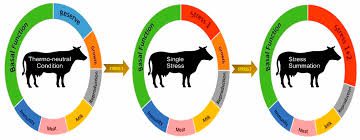With regards to Animal Energy Balance, since mammals and avian that form bulk of farm animals are homeotherms and hence maintain a constant body temperature, they possess means for producing and losing heat during extreme cold or heat muscular activities form the animal heat gain.
Hear Production: Animal produce heat when transforming chemical energy of food into work. Under normal circumstances a grazing animal while in the sun may gain heat directly or indirectly from solar radiation. The added solar heat and metabolic heat generated from food and muscular activities form the animal heat gain.
The heat gains (animal energy) in one animal vary from another as a result of:
- The intensity of heat production by different organs varies depending of the weight of the organ. On net weight basis, the brain generates heat faster than the muscular tissue due to higher density of the former
- The body size also affects heat requirement, for instance, smaller sized animal require a greater heat production per unit weight than larger sized animal if the same temperature is to be maintained. This is because the smaller the animal, the greater the surface area and the more heat loss
- Specific surface area which is the ratio of surface to volume determines heat loss. This is because with increasing body size, the surface to volume of the animal increases, and therefore the relative surface from which is dissipated increased. When heat production is better expressed per unit surface area, the effect of body size is largely eliminated. Heat production is better expressed in term of body surface area.
Evaporation: Evaporative water loss occurs from the skin after it has been secreted by the sweat glands. Other areas of evaporative of water losses include respiration water loss and sweating. The two forms of water are two major processes used in temperature regulation in animal.
The process of evaporation of water requires a large amount of energy and is therefore used to cool the body of animal. Evaporation occurs only when the air is not saturated already with water.
Read Also: Adaptive Means of Animals Coping with the Environment
Metabolic and Chemical Heat Transfer in Animal Energy
With increasing environmental temperature body in animal energy for homeotherm is constant while that for poikilotherm increases the metabolic rate and decreases with decreasing ambient temperature similar normal chemical reaction.
However, with homeotherms , the metabolic rate decreases with increasing temperature and increase with decreasing temperature. Other chemical reaction like muscular activities, shivering and metabolic reaction of the liver are also involved e.g. liver apart from producing heat also releases glucose into circulation which is a basic requirement for chemical temperature regulation.
Factors Affecting Heat Production in Animal Energy
Ingestion of food leads into in heat production which varies greatly with the type of nutrients ingestion. Also in ruminants the rumen micro-organism constitutes an auxiliary source of heat (about 10 per cent) in addition to the animal’s moral heat production. The fetuses as well as lactation add up to the amount of heat production by the dam.
During severe cold or active physical exercise, the heat generation by muscular activities increases while the heat from abdominal organ decreases. In cattle and sheep, heat production is about 1o per cent greater in standing position than in the lying position.
In pregnant animal, foetus metabolism together with the acceleration of body processes of the dam result in an increment in the total heat production.
The presence of brown fat is another source of heat production. Brown fat is found in rodent but has been found in other animals including man. It is especially useful in homeotherms exposed to cold and hibernators.
The brown adipose tissue is distributed around vital organs of the thorax, along sympathetic ganglia of the central nervous system around the cervical and thoracic segment of the spinal cord to prevent loss of heat and excessive cold from inactivating the function of the vital organs.
Both the metabolic and thermogenic action of the brown fat re by stimulation from sympathetic nervous system under cold condition.
Read Also: Trends in Crop Production Nationally and Globally
Heat loss: Heat loss from animal body is by two means:
- Sensible heat loss i.e. through radiation, convection and conduction
- Insensible that loss which is through evaporation of water.
Heat loss by means of sensible of sensible heat loss offers little or no control for the animal to regulate unlike insensible heat loss in which animal exerts market control.
Heat transfer by sensible heat can be in either direction of loss or gain, while insensible heat transfer is only along one direction i.e. through loss from animal to the environment.
Heat transfer involves two forms of gradient:
. Inner gradient and out gradient: Inner gradient concerns with heat flows from the core of the body to the surface of the body.
. Outer gradient on the other hand refers to the heat that goes from the surface of the body to the environment.
Heat transfer along the inner gradient is affected by conduction across the tissues and by convection by the blood. Along the outer gradient, heat transport is by the following:
- Convection across the hair coat and boundary layer of still air surrounding the body
- Convection from the boundary layer of air to the full moving air
- By radiation from the tips of the air across the boundary
- Evaporation across the hair coat and boundary layer.
Related: Advantages of Continuous Cropping as a Type of Cropping System
